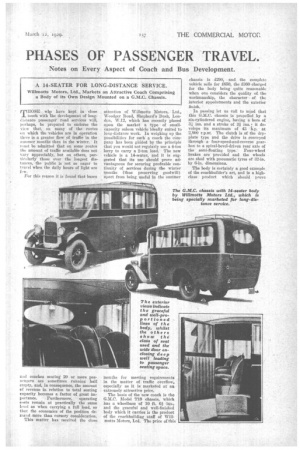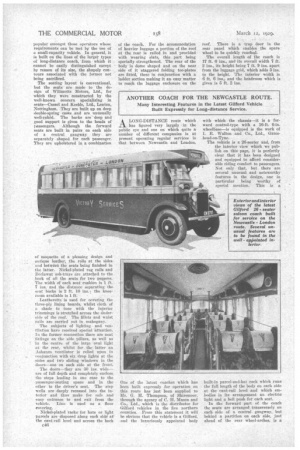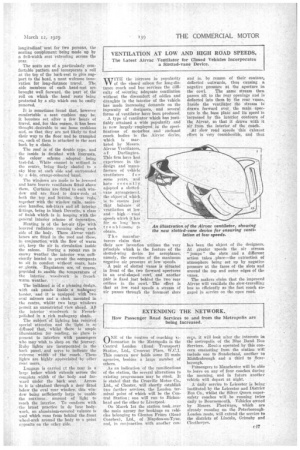PHASES OF PASSENGER TRAVEL.
Page 75

Page 76

Page 77

If you've noticed an error in this article please click here to report it so we can fix it.
Notes on Every Aspect of Coach and Bus Development.
rillIOSE who have kept in close 1 touch with he development of longdistance passenger road services will, perhaps, be prepared to endorse the view that, on many of the routes on which the vehicles are in operation -there is a greater flow of traffic in the summer months than in the winter. It mist be admitted that on some routes the amount of traffic available does not vary appreciably, but on others, partire-duly those over the longest dielances, the public is not so eager to travel when the daily hours of light are few.
For this reason it is found that buses
mid coaches seating20 or more passengers are sometimes running half empty, and, in consequence, the amount of revenue in relation to total seating capacity becomes a factor of great importance. Furthermore, operating costs remain at practically the same level as when carrying a full load, so that the economies of the position demand more than cursory consideration.
This matter has received the close
attention of Willmotts Motors, Ltd. Woodger Road, Shepherd's Bush, London, W.12, which has recently placed upon the market a type of smallcapacity saloon vehicle ideally suited to long-distance work. In weighing up the possibilities for such a coach the company has been guided by the principle that you would not regularly use a 4-ton lorry to carry a 2-ton load: The new vehicle is a 14-seater, and it is suggested that its use should prove advantageous for securing profitable continuity of services during the winter Tenths (thus preserving goodwill) apart from being useful in the summer
months for meeting requirements in the matter of traffic overflow, especially as it is marketed at an extremely attractive price.
The basis of the new coach is the G.M.C. Model T19 chassis, which has a wheelbase of 10 ft. 6,3.
and the graceful and well-finished body which it carries is the product of the coachbuilding staff of Will matte Motors, Ltd. The price of this
chassis is £290, and the complete vehicle sells for £650, the 360 charged for the body being quite reasonable when one considers the quality of the workmanship, the character of the interior appointments and the exterior finish.
In passing let us call to mind that this G.M.C. chassis is propelled by a six-cylindered engine, having a bore of 31 ins, and a stroke of 31 ins. • it develops its maximum of 43 ia.p. at 2,800 r.p.rrt. The clutch is of the dryplate type and the drive is conveyed through a four-speed-and-reverse gearbox to a spiral-bevel-driven rear axle of the semi-floating type. Four-wheel brakes are provided and the wheels are shod with pneumatic tyres of 82-in. by 6-in, dimensions.
The body is certainly a good example of the coaehbuilder's art, and is a highclass product which should prove
ropulur amongst those operators whose requirements can be met by the use of a small-capacity vehicle. In general, it is built on the lines of the larger types of long-distance coach, from which it cannot be easily distinguished except by reason of its size, the shapely contours associated with the former not being sacrificed.
The seating layout is conventional, but the seats are made to the design of Willmotta Motors, Ltd., for which they were constructed by the well-known concern specializing in seats—Cassel and Keeble, Ltd., Lenton, Nottingham. They are built up on deep double-spring eases and are unusually well-raked. The backs are deep and good support is given to the heads of passengers. Although the forward seats are built in pairs on each side of a central gangway they are separately shaped for each passenger. They are upholstered in a combination
of moquette of a pleasing design and antique leather, the rolls at the sides and between the seats being finished in the latter. Nickel-plated rug rails and .Lielawat ash-trays are attached to the. back of all the seats for two persons. The width of each seat cushion is 1 ft. 7 ins, and the distanec separating the seat backs is 2 ft. 10 ins.; the knee
room available is 1 ft Leatherette is used for aivering the three-ply lining boards, whilst cloth of a shade to tone with the interior trimmings is stretched across the tinderchic of the roof. The fillets and waist rails are carried out in mahogany.
The subjects of lighting and ventilation have received special attention. In the former connection there are neat fittings on the side pillars, as well as in the centre of the large oval light at. the rear, whilst for the latter an Asbanco ventilator is relied upon in conjunction with six drop lights at the Miles and two sliding windows in the .doors--one on each side at the front.
The doors—they are 30 ins, wide— are of full depth and completely enclose the steps leading in one ease to the passenger-seating space and in the other to the driver's seat. The step wells are deeply recessed into the interior and thus make for safe and easy entrance to and exit. from the Vehicle. Line is used as a floor covering.
Nickel-plated racks for hats or light parcels are disposed along each side at the cant-rail level and across the back c.4.6 of the coach. For the accommodation of heavier luggage a portion of the roof at the rear is railed in and provided with wearing slats, this part being specially strengthened. The rear of the body is dome shaped and on the near aide of it staggered folding toe-plates are fitted, these in conjunction with a ladder section making it an easy matter to reach the luggage enclosure on the roof. There is a trap door in the rear panel which enables the spare wheel to be quickly reached.
The overall length of the coach is 17 ft. 6 ins., and its overall Width 7 ft. 2 ins., its height being 7 ft. 9 ins, apart. from the luggage grid, which "adds 5 ins. to the height. The inferior" width is 6 ft. 6 ins., and the headroom which is given is 5 ft. 2 ins.
A LONG-DISTANCE route which has figured very largely in the public eye and one on which quite a number of different companies is at present operating regular services is that between Newcastle and London.
One of the latest coaches which has been built expressly for operation on this route has just been supplied to Mr. G. U. Thompson, of Shiremoor, through the agency of C. 11. Mason and Co., Ltd.,. which is the distributor for Gilford. vehicles in the five northern counties. From this statement it will be obvious that the vehicle is a Gifford, and the luxuriously appointed body
with which the chassis—it is a forward control-type with a 16-ft. 6-in. wheelbase—is equipped is the work of I. E. Walton and Co., Ltd., Gateshead-on-Tyne.
The vehicle is a 26-seater and, from the interior view which we publish on this page, it is perfectly clear that it has been designed and equipped to afford considerable riding comfort to passengers. Not only that, but there are several unusual and noteworthy features in the design, one in • particular being Worthy; of special mention. This is a parcel-and-hat rack which ruus the full length of the body on each side at the cant-rail . level and which embodies in its arrangement an "electric light and a bell push for each seat. In the forward part of the coach the seats arc arranged, transversely on each side of a central. gangway,. but behind a partition on each side, just ahead of the rear wheel-arches, is a
longitudinal: 'seat for. two persons, the seating comPleraent being made up by a full-width seat extending across the
rear. • The seats are of a particularly comfortable pattern and •incorporate a roll at the top of the back-rest to give support to the head, a most welcome innovation for long-distance travel. Thc. side members of each head-rest are brought well forward, the part of the roll on which the head rests being protected by a slip which can be easily removed.. • It is sometimes found that, however comfortable a seat cushion may be, it becomes set after a few hours of travel; and, for this reason, it has been thought .desirable to use loose cushions and, so that they are not likely to find their way to the floor and be trampled on, each of them is attached to the seat back by a chain.
The roof is of the double type, and the inside is finished with lincrusta; the colour scheme adopted being tasteful. White enamel is utilized in the centre, being finely shaded to a sky blue at each side and surrounded by a 4-in, orange-coloured band.
The windows are made to be lowered and have louvre ventilators fitted above them. Curtains are fitted to each window and are fixed to draw-rods at both the top and bottom, these reds, together with the window rails.ascension handles, ash-trays and all interior fittings, being in black Doverite, a class of finish which is in keeping with the general interior scheme of decoration.
Heating is of the hot-air type with louvred radiators running along each aide of the body. Three Airvac reati, 'Iators are fitted in the roof and these, in conjunction, with the flow of wenn air, keep the air in circulation inside the saloon. During a recent run in • snowy weather the interior was sufficiently heated to permit the occupants to sit in comfort without coats, hats or ,glovts. Regnlators are, .of course, provided to enable the temperature of the interior woodwork is french warm weather. • The bulkhead is of a pleasing design, with oak panels inside mohOiany border, and it is equipped with two oval mirrors and a clock mounted in the centre, whilSt two large windows permit an unrestricted view ahead. All the interior Woodwork is Frenchpolished in a rich mahogany shade.
The subjeet'of lighting has received , special attention and the light is so
• diffused that. Whilst there is ample illumination for reading, no glare is present to interfere with passengers who may wish to sleep on the journey. Ruby lights are incorporated in the back panel, and Serveto indicate the extreme width' of the coach. These lights are highly appreciated by other road users.
Luggage is carried rt the rear in a large locker which extends across the complete width of the body and forward under the back seat. Access to it is obtained through a door fitted below the oral rear Window, this window -being sufficiently large to enable the maximur amount of light to reacs the interior. To conform with the latest practice in de luxe bodywork, an aluminium-covered valance is used which runs from behind the front 'wheel-arch around the body to a point opposite on the other side. WITII the increase in popularity of the closed. saloon -for long-distance coach and bus services the difficulty of seeuring adequate ventilation without the discomfort of eddies and dkaughts in the interior of the vehicle his made increasing demands on the ingenuity of designers, and several forms of -ventilator have been produced-.
A type of ventilator -which -has justifiably attained a wide popularity and is' now largely 'employed in the specifications of motorbus and enelosed coach, bodies is the Airvac &Vice, which is marketed by Messrs. Airvac Ventilators, ofDarlington.
This firm have had
. . experience in the
design and -manufacture' of vehicle
veutilators . f a r sonic years, a Id have recently , adopted a slottedvane, arrangement. the olijectsof. whitdi is • to ensure just 'that balanee : of , ventilation at low . and high s; road speeds which it hie fer no troublesome' to obtain.
Ph e manufacturers' claim that their new 'invention utilizes the very principle which is the feature of the slotted-wins' device for aeroplanes, namely, the creation of the maximum negative air pressure at low speeds.
A pair of slotted Vanes is situated in front of the two forward apertures in an oval-shaped'cowl ; . and anether pair is flied just behind the two rear orifices in the cowl. , The effect is that at low road speeds a stream of air passes through the foremost slots
and . is, by reason of their contour, deflected outwards, thus causing a negative pressure at the aperture in
the cowl. The same stream then passes aft to the rear openings and is deflected into them b:y the rear vanes. Inside the ventilator. the 'stream is .drawn forward over the 'main aperture in the base Plate and its speed 'is -increased by the interior contours of the Airvac, so that it draws 'with it :air. from the interior of the coach.
At slow road speeds this exhaust effect is very Considerable, and that has been the object of the designers. At greater speeds the air stream " jumps " the slots and a different action takes . place—the extraction of atmosphere being • set up by negative pressure at the faces of the slots and around the top and outer edges of the vanes.
The makers 'claim that the improved Airvac will ventilate the slow-travelling bus as efficiently as the fast coach engaged in service on the open road.
.ONE of the ceistres of coaching SAformation in the Metropolis is the Central London (Road Transport) Station, Ltd., Crescent Place, 'W.0.1. This concernno heldS some 21 main 'agencies, besides a large number of others.
• -,As an indication 'of the ramifications of the station, the'several alterations to existing programmes may be cited. It is stated that the Crosville Motes Co., Ltd., of Chester, will shortly establish two further services, the London terminal point of which will be the Central Station ; one will run to Birkenhead and the other to' Liverpool.
On March 1st the station took over the main agency for bookings on vehicles belonging to Glenton Friars (Road Coaches), Ltd., of Blaydon-on-Tyne, and, in conjunction with another con cern, it will look after the interests in the metropolis of the Blue Band Bus Services. Boutcs operated by this concern emanating from the stationwill include one to Sunderland, another to Middlesbrough and a third to Scarborough.
Passengers to Manchester will be able to leave on any of four coaches during the morning, and in future another vehicle will depart at night.
A daily service to Leicester is being instituted-by the Leicester and District Bus Co., whilst the Silver. Queen supersafety coaches will be running twice daily to Bournemouth. Vehicles owned by Messrs. Fleetways, which are already miming on the PeterboroughLondon route, will extend the service to the districts of Lincoln, Grimsby and Cleethorpes.




























































































































